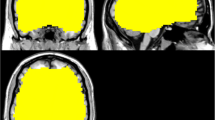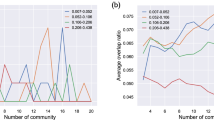Abstract
Variability of neuronal activity is considered as the fundamental mechanism for the flexible and optimal brain function. Moreover, different frequency neuro signal is related to specific function. While little is currently known regarding changes in spontaneous BOLD variability of schizophrenia. The current study used resting-state fMRI data from 53 chronic schizophrenic subjects and 67 healthy subjects to investigate this issue. The data-driven method was used to measure the BOLD variability (MSSD: mean square successive difference) in two different frequency bands respectively (slow-5: 0.01–0.027 Hz; slow-4:0.027–0.073 Hz). Schizophrenic subjects exhibited decreased BOLD variability in thalamus region, sensorimotor and visual networks, and increased BOLD variability in salience network compared to matched healthy controls. Moreover, the interaction effects between frequency and group were observed in thalamus and right dorsolateral prefrontal cortex (DLPFC). These findings identified that altered BOLD variability is frequency dependent in schizophrenia. Importantly, the severity of patients’ negative symptom was related to the increased BOLD variability of DLPFC within slow-4 frequency band, highlighting the evidence that abnormal BOLD variability of frontal cortex is likely to have effects on the pathophysiology of negative symptom in schizophrenia.




Similar content being viewed by others
References
Abi-Dargham, A. (2004). Do we still believe in the dopamine hypothesis? New data bring new evidence. International Journal of Neuropsychopharmacology, 7, S1–S5. https://doi.org/10.1017/S1461145704004110.
Abrol, A., Damaraju, E., Miller, R. L., Stephen, J. M., Claus, E. D., Mayer, A. R., & Calhoun, V. D. (2017). Replicability of time-varying connectivity patterns in large resting state fMRI samples. Neuroimage, 163, 160–176. https://doi.org/10.1016/j.neuroimage.2017.09.020.
Anticevic, A. (2017). Understanding the role of thalamic circuits in schizophrenia neuropathology. Schizophrenia Research, 180, 1–3. https://doi.org/10.1016/j.schres.2016.11.044.
Berman, R. A., Gotts, S. J., McAdams, H. M., Greenstein, D., Lalonde, F., Clasen, L., et al. (2016). Disrupted sensorimotor and social-cognitive networks underlie symptoms in childhood-onset schizophrenia. Brain, 139(Pt 1), 276–291. https://doi.org/10.1093/brain/awv306.
Bhugra, D. (2005). The global prevalence of schizophrenia. PLoS Med, 2(5), e151; quiz e175. doi:10.1371/journal.pmed.0020151.
Biswal, B., Yetkin, F. Z., Haughton, V. M., & Hyde, J. S. (1995). Functional connectivity in the motor cortex of resting human brain using Echo-planar Mri. Magnetic Resonance in Medicine, 34(4), 537–541. https://doi.org/10.1002/mrm.1910340409.
Bluhm, R. L., Miller, J., Lanius, R. A., Osuch, E. A., Boksman, K., Neufeld, R. W., Théberge, J., Schaefer, B., & Williamson, P. (2007). Spontaneous low-frequency fluctuations in the BOLD signal in schizophrenic patients: Anomalies in the default network. Schizophrenia Bulletin, 33(4), 1004–1012. https://doi.org/10.1093/schbul/sbm052.
Buzsaki, G., & Draguhn, A. (2004). Neuronal oscillations in cortical networks. Science, 304(5679), 1926–1929. https://doi.org/10.1126/science.1099745.
Buzsáki, G., & Draguhn, A. J. (2004). Neuronal oscillations in cortical networks. 304(5679), 1926-1929.
Carlsson, M., & Carlsson, A. (1990). Schizophrenia: A subcortical neurotransmitter imbalance syndrome? Schizophrenia Bulletin, 16(3), 425–432. https://doi.org/10.1093/schbul/16.3.425.
Chang, C., & Glover, G. H. (2010). Time-frequency dynamics of resting-state brain connectivity measured with fMRI. Neuroimage, 50(1), 81–98. https://doi.org/10.1016/j.neuroimage.2009.12.011.
Damaraju, E., Allen, E. A., Belger, A., Ford, J. M., McEwen, S., Mathalon, D. H., Mueller, B. A., Pearlson, G. D., Potkin, S. G., Preda, A., Turner, J. A., Vaidya, J. G., van Erp, T., & Calhoun, V. D. (2014). Dynamic functional connectivity analysis reveals transient states of dysconnectivity in schizophrenia. Neuroimage Clin, 5, 298–308. https://doi.org/10.1016/j.nicl.2014.07.003.
Dong, D., Duan, M., Wang, Y., Zhang, X., Jia, X., Li, Y., et al. (2018a). Reconfiguration of dynamic functional connectivity in sensory and perceptual system in schizophrenia. Cerebral Cortex. https://doi.org/10.1093/cercor/bhy232.
Dong, D., Wang, Y., Chang, X., Luo, C., & Yao, D. (2018b). Dysfunction of large-scale brain networks in schizophrenia: A meta-analysis of resting-state functional connectivity. Schizophrenia Bulletin, 44(1), 168–181. https://doi.org/10.1093/schbul/sbx034.
Dum, R. P., & Strick, P. L. (2003). An unfolded map of the cerebellar dentate nucleus and its projections to the cerebral cortex. Journal of Neurophysiology, 89(1), 634–639. https://doi.org/10.1152/jn.00626.2002.
Engel, A. K., Fries, P., & Singer, W. (2001). Dynamic predictions: Oscillations and synchrony in top-down processing. Nature Reviews Neuroscience, 2(10), 704–716. https://doi.org/10.1038/35094565.
Garrett, D. D., Kovacevic, N., McIntosh, A. R., & Grady, C. L. (2010). Blood oxygen level-dependent signal variability is more than just noise. The Journal of Neuroscience, 30(14), 4914–4921. https://doi.org/10.1523/JNEUROSCI.5166-09.2010.
Garrett, D. D., Kovacevic, N., McIntosh, A. R., & Grady, C. L. (2011). The importance of being variable. Journal of Neuroscience, 31(12), 4496–4503. https://doi.org/10.1523/Jneurosci.5641-10.2011.
Garrett, D. D., Samanez-Larkin, G. R., MacDonald, S. W. S., Lindenberger, U., McIntosh, A. R., & Grady, C. L. (2013). Moment-to-moment brain signal variability: A next frontier in human brain mapping? Neuroscience and Biobehavioral Reviews, 37(4), 610–624. https://doi.org/10.1016/j.neubiorev.2013.02.015.
Giraldo-Chica, M., & Woodward, N. D. (2017). Review of thalamocortical resting-state fMRI studies in schizophrenia. Schizophrenia Research, 180, 58–63. https://doi.org/10.1016/j.schres.2016.08.005.
Grace, A. A. (1991). Phasic versus tonic dopamine release and the modulation of dopamine system responsivity: A hypothesis for the etiology of schizophrenia. Neuroscience, 41(1), 1–24.
Hansen, E. C., Battaglia, D., Spiegler, A., Deco, G., & Jirsa, V. K. (2015). Functional connectivity dynamics: Modeling the switching behavior of the resting state. Neuroimage, 105, 525–535. https://doi.org/10.1016/j.neuroimage.2014.11.001.
He, H., Luo, C., Luo, Y., Duan, M., Yi, Q., Biswal, B. B., & Yao, D. (2018). Reduction in gray matter of cerebellum in schizophrenia and its influence on static and dynamic connectivity. Human Brain Mapping. https://doi.org/10.1002/hbm.24391.
He, H., Yang, M., Duan, M., Chen, X., Lai, Y., Xia, Y., Shao, J., Biswal, B. B., Luo, C., & Yao, D. (2017). Music intervention leads to increased insular connectivity and improved clinical symptoms in schizophrenia. Frontiers in Neuroscience, 11, 744. https://doi.org/10.3389/fnins.2017.00744.
Herrera, C. G., Cadavieco, M. C., Jego, S., Ponomarenko, A., Korotkova, T., & Adamantidis, A. (2016). Hypothalamic feedforward inhibition of thalamocortical network controls arousal and consciousness. Nature Neuroscience, 19(2), 290–298. https://doi.org/10.1038/nn.4209.
Jadi, M. P., Behrens, M. M., & Sejnowski, T. J. (2016). Abnormal gamma oscillations in N-methyl-D-aspartate receptor Hypofunction models of schizophrenia. Biological Psychiatry, 79(9), 716–726. https://doi.org/10.1016/j.biopsych.2015.07.005.
Javitt, D. C. (2009). Sensory processing in schizophrenia: Neither simple nor intact. Schizophrenia Bulletin, 35(6), 1059–1064. https://doi.org/10.1093/schbul/sbp110.
Knable, M. B., & Weinberger, D. R. (1997). Dopamine, the prefrontal cortex and schizophrenia. Journal of Psychopharmacology, 11(2), 123–131. https://doi.org/10.1177/026988119701100205.
Kurth, F., Zilles, K., Fox, P. T., Laird, A. R., & Eickhoff, S. B. (2010). A link between the systems: Functional differentiation and integration within the human insula revealed by meta-analysis. Brain Structure & Function, 214(5–6), 519–534. https://doi.org/10.1007/s00429-010-0255-z.
Li, C. S. R. (2002). Impaired detection of visual motion in schizophrenia patients. Progress in Neuro-Psychopharmacology & Biological Psychiatry, 26(5), 929–934. https://doi.org/10.1016/S0278-5846(02)00207-5.
Linnman, C., Coombs, G., Goff, D. C., & Holt, D. J. (2013). Lack of insula reactivity to aversive stimuli in schizophrenia. Schizophrenia Research, 143(1), 150–157. https://doi.org/10.1016/j.schres.2012.10.038.
Liu, F., Tian, H., Li, J., Li, S., & Zhuo, C. (2019). Altered voxel-wise gray matter structural brain networks in schizophrenia: Association with brain genetic expression pattern. Brain Imaging and Behavior, 13(2), 493–502. https://doi.org/10.1007/s11682-018-9880-6.
Liu, F., Wang, Y., Li, M., Wang, W., Li, R., Zhang, Z., Lu, G., & Chen, H. (2017). Dynamic functional network connectivity in idiopathic generalized epilepsy with generalized tonic-clonic seizure. Human Brain Mapping, 38(2), 957–973. https://doi.org/10.1002/hbm.23430.
Martinez, A., Hillyard, S. A., Dias, E. C., Hagler Jr., D. J., Butler, P. D., Guilfoyle, D. N., et al. (2008). Magnocellular pathway impairment in schizophrenia: Evidence from functional magnetic resonance imaging. The Journal of Neuroscience, 28(30), 7492–7500. https://doi.org/10.1523/JNEUROSCI.1852-08.2008.
Matsuo, K., Chen, S. H. A., Liu, C. M., Liu, C. C., Hwang, T. J., Hsieh, M. H., et al. (2013). Stable signatures of schizophrenia in the cortical-subcortical-cerebellar network using fMRI of verbal working memory. Schizophrenia Research, 151(1–3), 133–140. https://doi.org/10.1016/j.schres.2013.10.028.
Mier, D., Kirsch, P. (2015). Social-cognitive deficits in schizophrenia. In Social Behavior from Rodents to Humans (pp. 397-409): Springer.
Nomi, J. S., Bolt, T. S., Ezie, C. E. C., Uddin, L. Q., & Heller, A. S. (2017). Moment-to-moment BOLD signal variability reflects regional changes in neural flexibility across the lifespan. Journal of Neuroscience, 37(22), 5539–5548. https://doi.org/10.1523/Jneurosci.3408-16.2017.
Pizoli, C. E., Shah, M. N., Snyder, A. Z., Shimony, J. S., Limbrick, D. D., Raichle, M. E., Schlaggar, B. L., & Smyth, M. D. (2011). Resting-state activity in development and maintenance of normal brain function. Proceedings of the National Academy of Sciences of the United States of America, 108(28), 11638–11643. https://doi.org/10.1073/pnas.1109144108.
Power, J. D., Barnes, K. A., Snyder, A. Z., Schlaggar, B. L., & Petersen, S. E. (2012). Spurious but systematic correlations in functional connectivity MRI networks arise from subject motion (vol 59, pg 2142, 2012). Neuroimage, 63(2), 999–999. doi:https://doi.org/10.1016/j.neuroimage.2012.01.069.
Tapias-Espinosa, C., Río-Álamos, C., Sánchez-González, A., Oliveras, I., Sampedro-Viana, D., del Mar Castillo-Ruiz, M., . . . Fernández-Teruel, A. J. N. (2019). Schizophrenia-like reduced sensorimotor gating in intact inbred and outbred rats is associated with decreased medial prefrontal cortex activity and volume. 1.
Tognoli, E., & Kelso, J. A. (2014). The metastable brain. Neuron, 81(1), 35–48. https://doi.org/10.1016/j.neuron.2013.12.022.
Uhlhaas, P. J., & Singer, W. (2010). Abnormal neural oscillations and synchrony in schizophrenia. Nature Reviews Neuroscience, 11(2), 100–113. https://doi.org/10.1038/nrn2774.
Yan, C. G., Wang, X. D., Zuo, X. N., & Zang, Y. F. (2016). DPABI: Data Processing & Analysis for (resting-state) brain imaging. Neuroinformatics, 14(3), 339–351. https://doi.org/10.1007/s12021-016-9299-4.
Yang, G. J., Murray, J. D., Repovs, G., Cole, M. W., Savic, A., Glasser, M. F., Pittenger, C., Krystal, J. H., Wang, X. J., Pearlson, G. D., Glahn, D. C., & Anticevic, A. (2014). Altered global brain signal in schizophrenia. Proceedings of the National Academy of Sciences of the United States of America, 111(20), 7438–7443. https://doi.org/10.1073/pnas.1405289111.
Yu, R. J., Chien, Y. L., Wang, H. L. S., Liu, C. M., Liu, C. C., Hwang, T. J., et al. (2014). Frequency-specific alternations in the amplitude of low-frequency fluctuations in schizophrenia. Human Brain Mapping, 35(2), 627–637. https://doi.org/10.1002/hbm.22203.
Yuan, R., Di, X., Taylor, P. A., Gohel, S., Tsai, Y. H., & Biswal, B. B. (2016). Functional topography of the thalamocortical system in human. Brain Structure & Function, 221(4), 1971–1984. https://doi.org/10.1007/s00429-015-1018-7.
Zuo, X. N., Di Martino, A., Kelly, C., Shehzad, Z. E., Gee, D. G., Klein, D. F., et al. (2010). The oscillating brain: Complex and reliable. Neuroimage, 49(2), 1432–1445. https://doi.org/10.1016/j.neuroimage.2009.09.037.
Acknowledgments
This study was funded by the National Nature Science Foundation of China (grant number: 81801775; 31700947) and Advanced Talents Introduction Program of Chengdu Normal University (YJRC2017-4).
Author information
Authors and Affiliations
Contributions
Youxue Zhang had made a substantial contribution to the conception and drafting and revising the article; Youxue Zhang, Rui Yang and Xueli Cai had made a substantial contribution to the analysis and interpretation of the data, and then they gave final approval of the version to be published.
Corresponding author
Ethics declarations
Conflict of interest
No conflicts of interest to declare.
Ethical approval
All procedures performed in study involving participants were in accordance with the ethical standards of the Institutional Review Boards (IRB) o the USA.
Informed consent
Informed consent was obtained from all subjects included in the study.
Additional information
Publisher’s note
Springer Nature remains neutral with regard to jurisdictional claims in published maps and institutional affiliations.
Rights and permissions
About this article
Cite this article
Zhang, Y., Yang, R. & Cai, X. Frequency-specific alternations in the moment-to-moment BOLD signals variability in schizophrenia. Brain Imaging and Behavior 15, 68–75 (2021). https://doi.org/10.1007/s11682-019-00233-1
Published:
Issue Date:
DOI: https://doi.org/10.1007/s11682-019-00233-1




